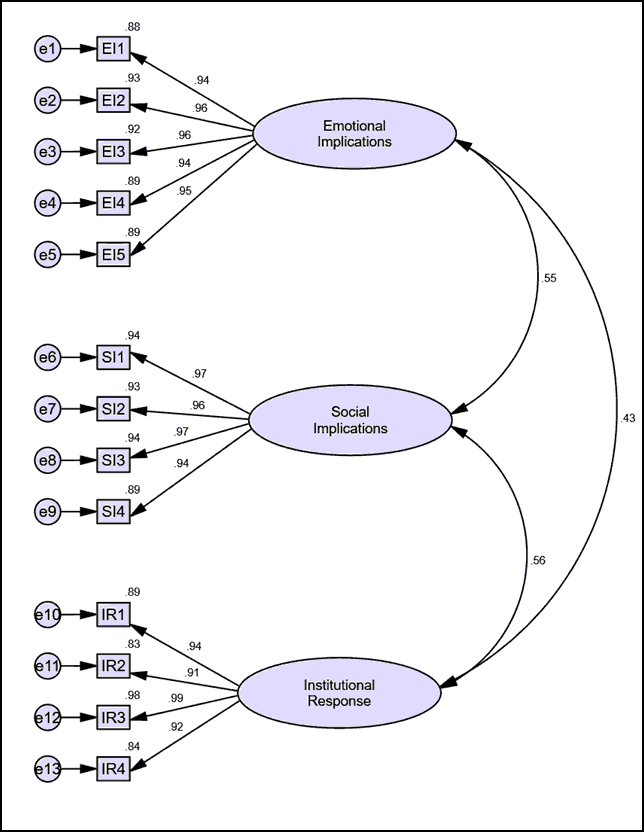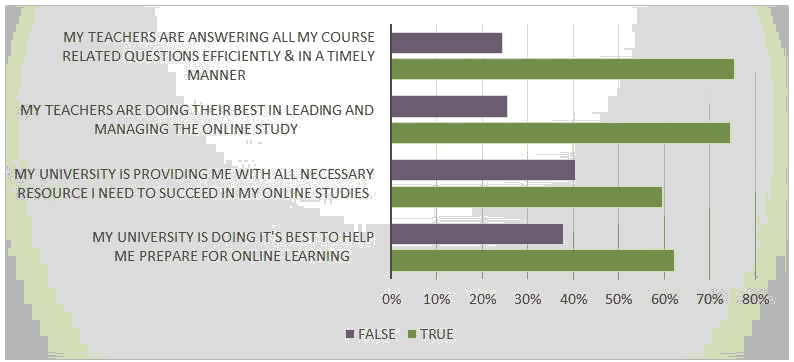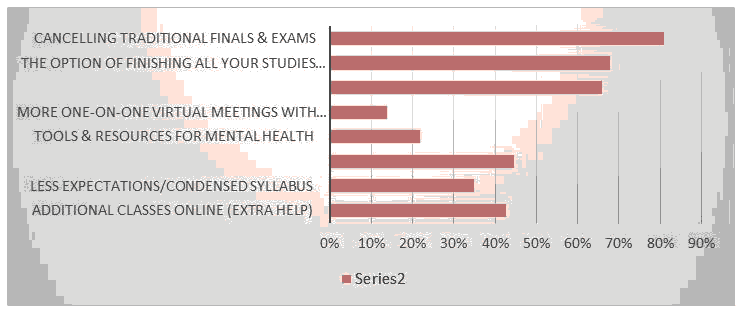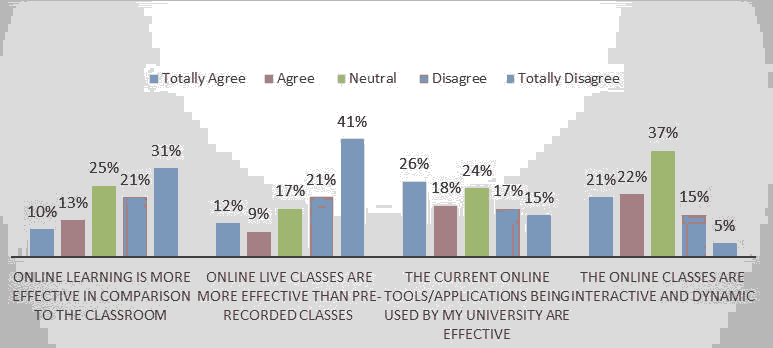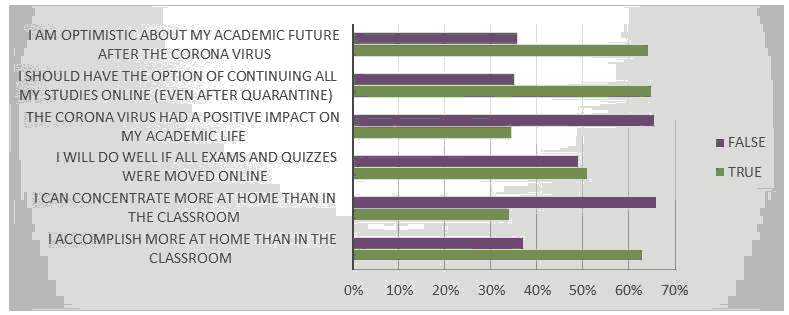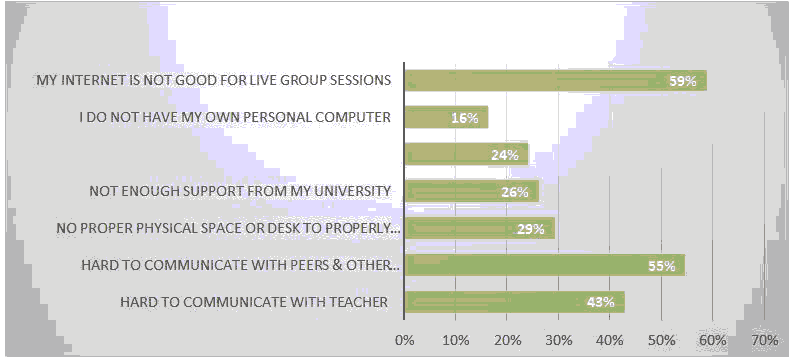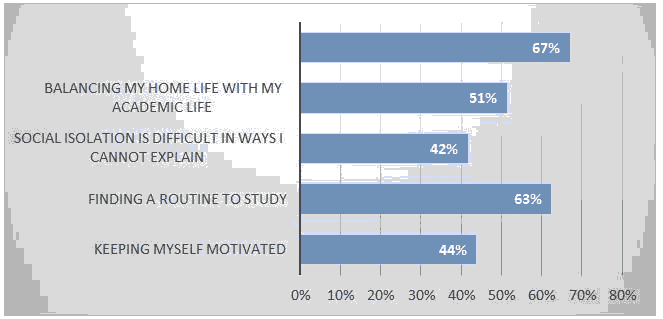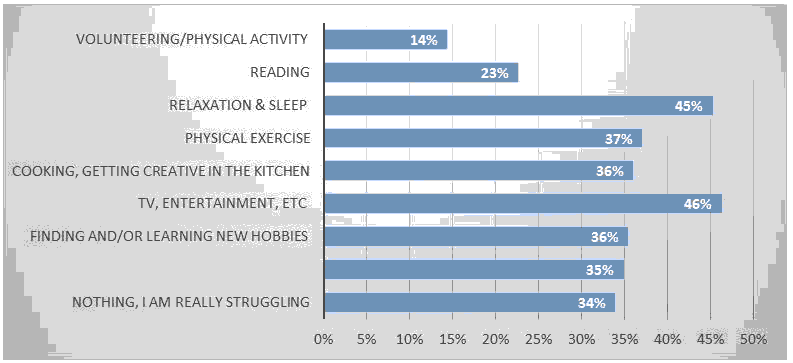Research Article: 2021 Vol: 24 Issue: 1S
Assessing the Use of VLEs During Covid 19: A Study of Undergraduate Students in Kuwait's Private Universities
Randa Diab-Bahman, Kuwait College of Science & Technology
Abrar Al-Enzi, Gulf University for Science & Technology
Abstract
During the Corona-19 pandemic, much of the conventional world has changed – especially the way students learn. Students globally experienced an abrupt and quick transition into e-learning involuntarily across all age groups. As lockdown measures were put in place, it was essential to investigate the impact of the abrupt changes on students, especially on a personal level, and understand how students perceived the way their institutes adjusted to the changes. In this paper, the sentiments of over 318 students were investigated from universities in Kuwait that are currently experimenting with Virtual Learning Environments as a medium of study for the first time. A questionnaire was developed and validated to examine the sentiments of the students. The theoretical framework of instrument development includes elements of previous instruments including Distance Education Learning Environments Survey (DELES) and the Online Learning Environment Survey (OLES). It was found that there are indeed social and emotional implications when comparing the switch to e-learning under stressful conditions in comparison to the conventional classroom setting. However, most students reported being satisfied with the efforts put forth by their academic institutes.
Keywords
VLE, Online Education, Higher Education, Covid-19
Introduction
Virtual Learning (VL) or otherwise known as e-learning has been around for quite some time. It is available as an option of study predominately for students of higher education and is generally accepted in the academic world. In the Middle East, higher education institutes were limited in their offering of VL as a means of study; however, the current pandemic quickly had the region explore and implement e-learning as a primary medium for the delivery of education. The aim of this research is to highlight the impact of the abrupt and quick move to an online environment on students of higher education by creating an instrument that is in line with the implications caused by the current pandemic. Undertaking this study is important in aiding the government, universities, and all related stakeholders to understand how VL can impact students, either positively or negatively, and thus help guide policies as the roll-out continues. Although new, these implemented mediums of education may open new doors for some as we experience the elimination of the brick-and-mortar method of teaching.
This study reaches out to students in higher education universities in Kuwait, in order to gain insight on their perspectives in terms of emotional impact, social impact, and overall sentiments regarding VL. It also sets out to construct and validate an instrument for assessing the mentioned matters. This insight, from a first-person point of view, will give feedback on the current efficiency and shortcomings of the educational system and the anticipated needs of the students involved, as they are the primary stakeholders. The outcomes will help further develop a policy that takes into account newly acquired statistics which may often be overlooked. Students’ perspectives in terms of emotional, social, and overall sentiments regarding the subject should be of primary concern as this new form of learning unveils for the first time.
Literature Review
A Learning Environment (LE) is defined as the social, physical, psychological, and pedagogical contexts in which learning occurs that impacts student achievement and attitudes (Trinidad et al, 2005). Nowadays, Virtual Learning Environments (VLE) have taken over which pertain to the same fundamental definition of LE. Yet, it is important to view any transition to a new medium of learning as a multi-faceted approach with multiple elements as it may cause implications to those involved. Currently, there is no specific study that has sought to investigate how VLE influences the process of education in Kuwait, let alone for the first time, involuntarily and during a pandemic. Although distance learning is not a new concept in the education sector, its implementation is rather new to local education institutes in Kuwait. Due to the impact of COVID-19, all education institutes in the Kuwait were forced to close their doors and turn to teaching virtually. In contrast, with the growth of the Information and communications technology (ICT), many universities and schools worldwide, such as the UAE, have already deployed and implemented ICT technologies in their own strategies (Alhogail & Mirza, 2011). By doing so, such countries continued promoting and improving their teaching and learning within schools and higher institutions, even with self- and distance learning.
Scientists argue that VLE’s main goal is to manage, motivate and ease the learning experience of students (Sneha & Nagaraja, 2013). According to Morais, et al., (2017), “the main potentiality of VLEs is the provision of a set of tools aiming to support the production and distribution of contents, communication, and the assessment of the teaching and learning process”. In addition, authors like Barker & Gossman (2013) also claimed that “VLEs boast a wide spectrum of research showing positive impacts across different contexts” (p. 22). To support the above statement, Dahlstrom, et al., (2014) research showed that VLE produce positive change in the learning experience within higher education. Other characteristics of using VLE platforms include flexibility (Alario et al., 2013) and accessibility (Nguyen, 2011), and engagement (Mogus et al., 2012). However, Crook (2000); Seabolt & Arends (2000); Muirhead (2001) expressed their opinion that virtual learning does not consider the social and emotional interactions that happens in a conventional classroom.
Hence, there is a plethora of information which highlights the advantages and disadvantages of using virtual learning, but a dearth of information about how they can impact other elements of the students’ experience - including emotional and social implications, especially during a pandemic and in a situation where distance learning was not a voluntary choice of study. By using VLE in universities for the first time in Kuwait, the researchers question how students feel when they are experiencing this medium of study for the first time and during a pandemic. Below further explains the possible social and emotional implications which could exist.
Emotional Implications
Stress and Anxiety
In spite of being in a technological era, many students might still feel challenged using some types of educational technology, especially those who are not updated with technology (Mosquera, 2017). In addition, educators frequently use tests and assessments to evaluate students’ progress and accomplishment of their learning, yet they ignore the psychosocial parts of the classroom (Fraser, 2012). In Simsek’s (2008) study, students expressed their inclination for pencil and paper tests versus online tests. They contended that online tests caused them more anxiety tensions, were progressively more difficult and they did not receive much feedback from their teachers. Similarly, in Ushida's (2005) investigation, students indicated a significant level of anxiety during their online courses, due to the absence of formality with the use of some virtual learning features, which thus affected their motivation level. Moreover, due to the age differences, most university lecturers, like most schoolteachers, are ‘digital immigrants’ and most students are ‘digital natives’ (Walker & White, 2013). This can cause much confusion and lack of communication as the knowledge gap becomes apparently clear.
Emotion and Motivation
From previous studies, such as those done by Buck (1988); Lazaros (1991) and more recent by Reeve (2018), there is a clear positive correlation between motivation and emotion. It is, in the case of a pandemic, appropriate to extrapolate conclusions which state that negative emotions can create lack of motivation. It is safe to assume that isolation impact emotions, leading one to conclude that it may therefore effect motivation. Also, without strict control and deadlines, it is difficult for students to remain focused and concentrate viably.
Social Implications
Family Obligations
As known, Kuwaiti families are commonly closed and private as described by Al-Mekaimi (2003). Individuals within a family help and support each other, unite when needed, and are frequently considered as a pool of resources (Al-Mekaimi, 2003). Furthermore, social norms dictate that individuals marry at a young age, especially women. It is common for women to be married while attending their higher studies (Alqabas, 2020). Moreover, viewing Kuwaiti society through Hofstede’s theory (Hofstede, 1997), one can argue that it is a collectivist society where goals are set with major consideration of others and the culture is tightly united. Secondly, Kuwait is relatively a feminine society where the quality of life is a sign of success (Kaufman, 2014). Hence, Kuwaitis work for a living, problems are solved through negotiations, and individuals focus on the welfare of others. Thirdly, Kuwaiti society is a significantly high-power distance culture (Hofstede & Hofstede, 2005). Youths, for instance, are expected to be obedient towards their parents and respect those who are in power. Lastly, Kuwaitis also avoid uncertain situations (Hofstede & Hofstede, 2005). Therefore, the Kuwaiti society is classified as a collectivist, relatively feminine society that stresses high power distance and high uncertainty avoidance.
Moreover, being in a collective society, students are obligated to fulfil many family obligations; especially those who are parents and studying at the same time. Hence, finding the time to balance between being parents and studying can be quite difficult. With the increase of responsibilities enforced by the pandemic due to the lockdown situation, family obligations may have an impact on students, especially females with children to take care of.
Institutional Response
Workload
The lack of prior training of teachers for online methods could easily lead to a situation where VLE becomes a one-way channel of communication and students end up bearing most of the learning and teaching responsibilities, as described by Demian & Morris (2012). Moreover, according to Risquez, et al., (2013), an overload of tasks could lead students to believe that virtual learning is useless, confusing and overwhelming, in comparison to traditional learning Therefore, they propose that VLE be used as a distribution platform for materials instead of being used for complex activities such as online quizzes and homework. Moreover, in the work of Demian & Morrice (2015), the number of students who were reported to visit VLE platform are very few, suggesting that students do not rely on them as source as much as initially thought. This is further supported by Demian & Morris (2012) who found that there was no correlation between students’ final grades and the number of times they accessed a VLE platform.
Theoretical Framework
Over the previous years, learning environment research has demonstrated to be helpful in tending numerous educational matters and emphasized on ways how psychosocial factors are significant in promoting innovative learning conditions inside a classroom (Khine et al., 2017). Although there exists a plethora of questionnaires to test variables of the classroom experience, such as classroom contexts (Fraser, 1998a), individualised classrooms (Fraser, 1999) and constructivist classrooms (Taylor et al., 1997), there have been a few like The & Fraser (1995); Taylor & Mao (2000); Fraser & Mao (2000) that investigated VLE usage. However, not many studies have been particularly established under the stress of a health pandemic/in a worldwide lockdown. As educational institutes raced towards e-learning due to the pandemic, many have developed VLE’s primarily around content. This, according to Trinidad, et al., (2001), usually results in a heavily linear approach to the use of technologies.
In addition, previous questionnaires that enhanced the e-learning assessment literature, such as those done by Fraser, McRobbie & Fisher (1996); Fraser (1994) and Aldridge et al. (2004), have all borrowed questions from former questionnaires while adding some significant dimensions to the mix of questions. For this research, the basis for the questionnaire development was in line with Moos’ (1974) work that classifies the dimensions of a generic human environment. Moos’ (1974) work has inspired many diverse research programs around the world like Fraser (1994, 1998a) as well as Trinidad, Aldridge & Fraser (2005). The dimensions mentioned are of relevance to this paper as they help assess the various elements of e-learning. Also, the assessment tool developed for the sake of this research also borrows from the existing OLES instrument developed by Trinidad, et al., (2005) as well as the DELES instrument which was previously developed (Walker & Fraser, 2005).
The OLES (Trinidad et al., 2005) questionnaire was administered to 325 students and takes into account four other instruments, particularly the ‘What Is Happening In this Class?’ (WIHIC) (Fraser et al.,1996) questionnaire, the Constructivist Learning Environment Survey (CLES) (Tayloret et al., 1997), the Distance Education Learning Environments Survey (DELES) (Jegedeet et al., 1995; Walker, 2002) and the Technology Rich Outcomes Focused Learning Environment Instrument (TROFLEI) (Aldridge et al., 2004; Aldridge et al., 2003). Three scales from the WIHIC were selected – Teacher Support, Student Autonomy and Equity. Meanwhile, DELES was developed using 34 items allocated to six scales – Instructor Support, Student Interaction and collaboration, Personal Relevance, Authentic Learning, Active Learning, and Student Autonomy (Walker & Fraser, 2005). Four scales from the DELES were used as part of the OLES instrument – Authentic Learning, Student Interaction & Collaboration and Asynchronicity. Finally, one scale from each of the CLES and TROFLEI – Personal Relevance and Computer Usage, respectively (Trinidad et al., 2005). Along with the mentioned foundations for the survey questions, VLE variables discussed in the literature review were used as well.
Methodology and Objective
This study employs a primary quantitative approach as it is descriptive in nature and uses a closed-answer survey. This data-oriented approach is best described as a causal-comparative in that it aims to find an impact of an element on a group, or a factor for comparison. Also called the quasi-experimental research, this quantitative research method is used by researchers to conclude cause-effect equation between two or more variables, where one variable is dependent on another independent variable (Chiang et al., 2015).
Questionnaire Development
Although this research is primarily qualified as a quantitative one, it also arguably had an underlying qualitative element as well. The development of the research instrument, the survey, uses the logic of a restricted phenomenological approach in order to serve its purpose of gaining feedback from a first-person point of view. This selected approach is meant to elucidate the experience as lived by a group of people. Patton (2001) notes that a phenomenological study is one that focuses on the description of what people are doing and how they experience what they experience. One key element of the phenomenological approach is that it assumes there is an essence to a shared experience.
Thus, due to the lockdown circumstances, the survey used a phenomenological approach to help design the closed-ended questions, in that a group of family and friends were interviewed face to face in order to objectify what they were experiencing and further justify the questions from the assessment tools borrowed. A phenomenological study usually expects the researcher to derive meaningful research questions that relates to the lived experience of the individual (Creswell, 1998). In order to conduct this, Creswell (1998) states that it must be done through face-to-face interviews with individuals who have experienced the phenomenon. However, from a more liberal research perspective, in her research on whether remote surveys can be categorized as part of a qualitative phenomenological study, Sweet (2002) argues that remote interviewing is a methodologically and economically valuable data collection technique in qualitative research. She further argues that qualitative researchers should not rely exclusively on the face-to-face interview, as remote meetings like telephone interviews can be an equally valuable data collection approach. Using this logic and given the Covid-19 pandemic situation of imposed lockdowns, meetings were done virtually one-on-one with close family and friends who are living the experience of studying from home.
Validation of Constructs
This study comprised of 3 latent constructs and these comprised of Institutional Response (IR), Social Implications (SI) and Emotional Implications (EI). To test the construct validity for each of the latent variables, according to Dimitrov (2014), this entailed the use of CFA to test for convergent validity and discriminant validity. IBM SPSS Amos v27 was used to model the confirmatory factor analysis measurement model. The measurement model is presented below.
Convergent Validity
With respect to convergent validity, this tested whether all items for each dimension did converge or not. For the items to converge, they ought to have an unstandardized coefficient of 0.6 and a standardized path coefficient of at least 0.4 (Tabachnick & Fidell, 2007; Schmitt, 2011; Hair et al., 2014). The convergent validity results are presented in Table 1 below.
| Table 1 Convergent Validity ? Path Coefficients |
|||||
|---|---|---|---|---|---|
| Estimate | Standardised | S.E. | C.R. | P | |
| EI1<---EI | 1.013 | 0.938 | 0.042 | 24.253 | *** |
| EI2<---EI | 0.997 | 0.964 | 0.036 | 27.619 | *** |
| EI3<---EI | 0.997 | 0.96 | 0.037 | 27.074 | *** |
| EI4<---EI | 0.962 | 0.944 | 0.039 | 24.939 | *** |
| EI5<---EI | 1 | 0.945 | |||
| SI1<---SI | 0.998 | 0.968 | 0.035 | 28.149 | *** |
| SI2<---SI | 1.018 | 0.963 | 0.037 | 27.379 | *** |
| SI3<---SI | 1.024 | 0.969 | 0.036 | 28.258 | *** |
| SI4<---SI | 1 | 0.944 | |||
| IR1<---IR | 1.004 | 0.944 | 0.045 | 22.08 | *** |
| IR2<---IR | 0.944 | 0.91 | 0.048 | 19.578 | *** |
| IR3<---IR | 1.008 | 0.991 | 0.038 | 26.487 | *** |
| IR4<---IR | 1 | 0.916 | |||
For Institutional Response (IR), the minimum standardized coefficient was 0.910 (p<0.05) for IR2 followed by 0.916 (p<0.05) for IR4. For Social Implications (SI), the minimum standardized coefficient was 0.944 (p<0.05) for SI4 followed by 0.0.963 (p<0.05) for SI2. For Emotional Implications (EI), the minimum standardized coefficient was 0.938 (p<0.05) for EI1 followed by 0.944 (p<0.05) for EI4. Since none of these minimum coefficients were less than 0.40, the convergent validity of all the three constructs was confirmed. The validity was also confirmed from the Average Variable Explained (AVE) in the table below.
| Table 2 Validity And Reliability |
|||||||
|---|---|---|---|---|---|---|---|
| HTMT | |||||||
| CR | AVE | MSV | MaxR(H) | EI | SI | IR | |
| EI | 0.979 | 0.903 | 0.3 | 0.98 | 0.95 | ||
| SI | 0.98 | 0.924 | 0.319 | 0.981 | 0.548*** | 0.961 | |
| IR | 0.969 | 0.886 | 0.319 | 0.987 | 0.429*** | 0.565*** | 0.941 |
None of the AVE statistics was less than the minimum expected 0.60 and this confirms that there was convergent validity present among the constructs used. The discriminant validity results are presented in the next section.
Discriminant Validity
According to Grolemundand Wickham (2017), discriminant validity, tests whether the constructs are different from each other or not. The corresponding tolerable upper threshold is 0.85 for the covariances between any two given dimensions (Schmitt, 2011; Hair et al., 2014). The corresponding results are presented in Table 3.
| Table 3 Discriminant Validity |
|||||
|---|---|---|---|---|---|
| Covariances | HTMT | S.E. | C.R. | P | |
| IR<-->EI | 0.173 | 0.429 | 0.037 | 4.741 | *** |
| IR<-->SI | 0.234 | 0.565 | 0.04 | 5.848 | *** |
| EI<-->SI | 0.251 | 0.548 | 0.044 | 5.759 | *** |
The results above show that the highest covariance was 0.251 (p<0.05) and this was observed between EI and SI, followed by the covariance between IR and SI, which was 0.234. The least covariance was 0.093 (p<0.05) and this was observed between IR and EI (0.173). From the foregoing, since all the covariance coefficients were less than 0.85, the researcher confirms that the discriminant validity between the constructs was not violated. The discriminant validity was further validated by the Heterotrait-Monotrait (HTMT) ratio of correlations. According to Schmitt (2011), the maximum acceptable HTMT ratio is 0.85 and again, from the foregoing findings, none of the HTMT statistics was greater than the threshold. In this regard, having validated the convergent validity and discriminant validity, the researcher confirms that the three constructs used were valid.
Data Collection
Survey
A close-ended questionnaire in the form of a survey will assess relevant topics about the issue being addressed. After constructing the anonymous questionnaire, it was distributed to undergraduate students in Kuwait currently experiencing virtual learning to self-administer. Data was manually checked to ensure that respondents were indeed experiencing VLE for the first time. The questions derived for this study have been broken down by categories in order to be able to compare the pre-Covid-19 experience given the dependent variable (undergraduate students in higher education) &their current experience given the independent variable (Covid-19 pandemic). Three main constructs were used – Social Impact (SI), Emotional Impact (EI), Institutional Response (IR) in accordance to with the literature review. It also includes foundational elements from the works of Moos (1974), OLES (Fraser et al, 2005) and DELES (Walker & Fraser, 2005) as specified below in table 4:
| Table 4 Survey Questions Construct |
|||||
|---|---|---|---|---|---|
| Construct | VLE Component | MOOS | DELES | OLES | Question No. |
| IR | Physical & Psychological | System Change Dimension | Equity | Teacher Support | 1,2 |
| SI | Social | Relationship Dimension | Student Autonomy | Asynchronicity | 3,5,7 |
| EI | Pedagogical | Personal Development | Enjoyment | Personal Relevance | 4,6 |
Analysis
After conducting the quantitative research, data collection tools will then be reviewed to ensure that all questions have valid responses. Descriptive analysis will be conducted to narrate the results of the survey. Each segment will be thoroughly analyzed. With regards to the quantities research, the results of the analysis will then be interpreted, and the findings will be presented using statistical graphs as instruments to ease the process of result interpretation.
Sample
The questionnaire was self-administered via online mediums to a non-probability sample of 450 undergraduates in three different universities in Kuwait and 318 responses came back, fairly distributed amongst the three universities being investigated. This purposeful sampling technique was primarily used due to the given lockdown situation which restricted access to most students, as well the snowball sampling technique was used which encouraged students to send the survey to their friends in order to ensure fair representation of the three universities. Also, using a relatively more homogeneous group, such as undergraduate students, is particularly helpful to minimize random error that might occur by using a heterogeneous sample such as the general public (Calder et al., 1981). This is because the likelihood of error within the measurement model being inflated by situational factors inherent in diverse samples (e.g., age, income and social class) is reduced when respondents are homogeneous across demographic and behavioral characteristics (Assael & Keon, 1982).
Research Objectives
The objective of this research is to give feedback from a first-person point of view on the impact of the pandemic on students of higher education. It includes:
• Validate a construct for assessing student’s first time use of VLE using
• Review overall emotional impact of VLE on higher education students
• Review overall social impact of VLE on higher education students
• Review overall student’s sentiments of their institution’s VLE strategy & roll-out
Scientific Contribution
The importance of this research is to explore the efficiency of the long-awaited and much needed contingency plan for higher education purposes. It is necessary to have all the tools ready and in place ready to go once they are needed. Given the history and current situation of this country and the entire region, it is time that such emergency measures are considered and explored. The recommendations from this research will help:
? Provide evidence-based feedback for the current adoption of VLE in higher education
? Outline the expectations and struggles of VLE currently experienced by local students
? Provide a valid assessment tool for using VLE
As the pandemic continues to unleash its destruction, policy makers in Kuwait and the world are encouraged to consider adopting VL as a credible source of learning and invest in learning how to enhance it. Shedding the light on such conversation is no easy task and bringing them to the relevant table is an even harder one. However, looking into the future, it seems rather essential that more importance is given to the ultimate stakeholders and empowering their voices will only benefit the system. The outcome from this study may encourage the development of a thorough framework and encourage the acceptance of VLE's a long-term option for education.
Data Findings
The findings of the individual question of the survey are portrayed below in their unique tables.
When asked about how well their university did as they rolled-out virtual learning:
Analysis: The results of figure 2 indicate that most respondents felt that their university did fairly well in response to their first time engaging in virtual learning. More than 60% of the respondents answered positively when asked about the cooperativeness and engagement of their teachers in VLE.
When asked about how their university can further assist with virtual learning:
Analysis: The majority of students expect their institutes to re-examine their policies and outlines and consider cancelling traditional formats of assessments like exams. The majority also want the option of having online classes well beyond the Covid-19 pandemic and encourage the notion of having a hybrid model of having some classes online while others on campus. About 45% of the students expect some form of assistance on awareness matters which deal with balancing the home-workload of virtual learning, while 43% expect additional classes to be available during the crisis in case they have individual needs as shown in figure 3 below.
When asked about the efficiency of virtual learning in comparison to in-class teaching:
Analysis: As shown in figure 3 below, over 60% of students disagreed or totally disagreed that virtual learning is more effective than in-class learning and that online live classes were less effective than pre-recorded classes. This can be due to the fact that English is their second language, and they rely heavily on translational tools and peer interaction, which can be limited online or during a live session. The majority of them also recorded that they were happy with online applications being used by their university and were at least neural or more towards
When asked about their general sentiments regarding the impact of the pandemic on motivation:
Analysis: As shown in figure 5, most students were optimistic about their academic future and felt that they should have the option of continuing online studies beyond the pandemic. However, they felt that the Covid-19 pandemic did not have a positive impact on their academic life possibly due to the abrupt changes and elongating the time of finishing a typical semester. Moreover, they were almost evenly split as to how well they think they will do with online exams and quizzes as the time constraint and lack of face-to-face interaction with teachers is minimized. Finally, the majority found that they cannot concentrate more at home than in the classroom as expected with a full house on lockdown. Yet, they found that they can accomplish more at home than in the classroom possibly due to the fact that they can decide their own hours of learning.
When asked what obstacles they experienced during their first time trying virtual learning:
Analysis: Most respondents did not have an ideal internet connection possibly due to the high usage of internet around the world. Also, the majority reported obstacles in not being able to communicate with their peers as that appears to be an integral part of their overall learning process, as demonstrated in figure 6.
When asked how they felt emotionally as they experimented with virtual learning:
Analysis: As shown in figure 7 below, the majority of students reported being worried about the pandemic and that it affected their ability to study as well as having a hard time adjusting to the new home life-academic life balance. Also, 63% reported finding a routine to study while at home as they experience being primarily responsible for working out their own study schedules.
When asked how they personally dealt with the lockdown:
Analysis: As shown in figure 8 above, about 34% of the respondents reported that they are really struggling with the current Covid-19 situation of lockdown. This is understandable as new norms are being established both physically and emotionally. Others reported relaxing and sleeping (45%) as well as resorting to TV & similar entertainments (46%). Only 14% of students volunteered or took up physical activity, which could suggest to institutes that they should include such aspects into their VLE frameworks.
Limitations
In this study, only three out of the seven local private and public institutes were included in the survey as they were, at the time, the only ones undergoing VLE for the first time. Perhaps a bigger investigation can follow which can involve all local higher education institutes. Also, a bigger population sample will always yield more accurate results. Moreover, the number of questions in the survey administered was limited to seven. Also, due to the lockdown situation, it was impossible to talk about the experience with the students face-to-face. Perhaps, in the future, a phenomenological approach could be incorporated in the design of such feedback surveys in way of virtual face-to-face meetings so as not to impose a certain bias of experience. In such an approach, students can report their experiences freely as experiences without any prejudice. This is necessary as the Covid-19 pandemic is a new experience with complex implications and should be examined from multiple angles. As well, it is important to review new definitions of VLE and possibly more variables which may have aroused during the pandemic’s extensive use. More literature and academic findings are surely available also nowadays on the matter than at the time of writing this paper, therefore it is essential to compare the implications in the initial stages of implementation and the present time.
Conclusion
As the world adjusts to the new norms of society and how it is run, it is important to involve the experiences of all stakeholders involved. Since this is the first-time students and organisations of higher education are experiencing VLE so extensively, it is important to proactively monitor their progress. In this study, as reported from student’s first-person point of view, it was found that the impact of the Covid-19 pandemic has impacted higher education students both socially and emotionally and that impact has in turn impacted their ability to learn virtually and find the new method efficient. Furthermore, students reported their general sentiments as to their respective institutes’ VLE strategy and a new assessment tool for VLE usage was validated and used.
Lastly, it is essential that a proactive monitoring process is in place which gives the students an opportunity to give feedback promptly. This is integral to the success of the strategy of the institute as it unfolds VLE platforms for the first time and will very likely prevail as its most important element. From the survey, it is obvious that the social and emotional impact of the Covid-19 situation has affected efficiency elements of the now-on-line educational process. It is also important to pay attention to the way the institute and teachers have cooperated with students in order not to cause an overload of information and leaning responsibilities of students. As it stands, the pandemic is a stressful and confusing event for all alike and extra precaution must be taken when impressionable young adults are involved in order not to inflict more emotional and social pressures.
Future Research
It is certainly advisable to build upon this research and investigate the subject matter on a grand scale. Students, who are the primarily stakeholders, are experiencing VLE for the first time and could face a magnitude of challenges. Having their feedback is essential and integrating their needs into the VLE model can contribute to the sustainability of the model and the greater society as a whole. Research can include a wider scope, perhaps on K-12 education, and include institutes of both the public and private sector. Also, other stakeholders can be investigated, like parents who are expected to participate in this new study mode especially those in younger grades. A look into gender implications regarding the subject and possible correlations could also prove purposeful. Governments and policy makers could use such research to come up with optimal solutions on a grand scale.
Authors' Contributions
RDB analyzed and interpreted the student data regarding the impact of VLE. AE performed the construct validity & questionnaire. Both authors were major contributors in writing the manuscript and read and approved the final manuscript".
References
- Al-Mekaimi, H. (2003). The politics of the Islam movement: Uzbekistan, Saudi Arabia and Kuwait: A comparative study. Boston: Boston College.
- Aldridge, J.M., Dorman, J.P., & Fraser, B.J. (2004). Use of multitrait-multimethod modelling to validate actual and preferred forms of the Technology-Rich Outcomes-Focused Learning Environment Inventory (TROFLEI). Australian Journal of Educational & Developmental Psychology, 4, 110-125.
- Aldridge, J.M., Laugksch, R.C., Fraser, B.J., & Seopa, M.A. (2004). Development of an instrument for monitoring the success of outcomes-based learning environments in classrooms in South Africa. Greenwich, CA: Information Age Publisher.
- Aldridge, J., Fraser, B., Fisher, D., Trinidad, S., & Wood, D. (2003). Monitoring the success of an outcomes-based, technology-rich learning environment. Chicago: IL.
- Alhogail, A., & Mirza, A. (2011). Implementing a Virtual Learning Environment (VLE) In a higher education institution: A change management approach. Journal of Theoretical and Applied Information Technology, 31(1), 42- 52.
- Assael, H., & Keon, J. (1982). Non-sampling vs. sampling errors in survey research. Journal of Marketing, 46(2), 114-123.
- Barker, J., & Gossman, P. (2013). The learning impact of a virtual learning environment: Students’ views. Teacher Education Advancement Network Journal, 5(2), 19-38.
- Buck, R. (1988). Human motivation and emotion (2nd Edition). John Wiley & Sons.
- Calder, B.J., Philips, L., &Tybout, A. (1981). Designing research for application. Journal of Consumer Research, 8, 197-207.
- Crook, C.K. (2000). Motivation and the ecology of collaborative learning rethinking collaborative learning. Free Association, 161-178.
- Dahlstrom, E., Brooks, C., & Bichsel, J. (2014). The current ecosystem of learning management systems in higher education: Student, Faculty, and IT Perspectives. Research report. Louisville, CO: ECAR.
- Demian, P., & Morrice, J. (2012). The use of virtual learning environments and their impact on academic performance. Engineering Education, 7(1), 11-19.
- Fraser, B.J. (1994). Research on classroom and school climate. Handbook of research on science teaching and learning. New York: Macmillan.
- Fraser, B.J. (1998a). Science learning environments: Assessment, effects and determinants. International handbook of science education. Dordrecht, Netherlands: Kluwer.
- Fraser, B.J. (1998b). Classroom environment instruments: Development, validity and applications. Learning Environment Research: An International Journal, 1, 7-33.
- Fraser, B.J. (1999). Using learning environment assessments to improve classroom and school climates. London: Falmer Press.
- Fraser, B.J. (2002). Learning environment research: Yesterday, today and tomorrow. Studies in educational learning environments: An international perspective. Singapore: World Scientific.
- Fraser, B.J. (2012). Classroom learning environments: Retrospect, context and prospect. Second international handbook of science education. New York: Springer.
- Fraser, B.J. (2014). Classroom learning environments: Historical and contemporary perspectives. Handbook of research on science education. New York: Routledge.
- Fraser, B.J., & Fisher, D. (1983). Student achievement as a function of person environment fit: A regression surface analysis. British Journal of Educational Psychology, 53, 89-99.
- Fraser, B.J., & Maor, D. (2000). A learning environment instrument for evaluating students’ and teachers’ perceptions of constructivist multimedia learning environments. New Orleans, LA.
- Fraser, B., Fisher, D., & McRobbie, C. (1996). Development, validation and use of personal and class forms of a new classroom environment instrument. Paper presented at the annual meeting of the American Educational Research Association, New York.
- Grolemund, G., & Wickham, H. (2017). R for Data Science. O'Reilly Media: Gravenstein Highway North, Sebastopol, Canada.
- Hair, J.F., Hult, G.T.M., Ringle, C., &Sarstedt, M. (2014). A primer on Partial Least Squares Structural Equation Modelling (PLS-SEM). Sage Publications.
- Hofstede, G. (1997). Cultures and organisations: Software of the mind. London: McGraw- Hill.
- Hofstede, G. (1997). Cultures and organisations: Software of the mind. London: McGraw- Hill.
- Jegede, O., Fraser, B., & Fisher, D. (1995). The development and validation of a distance and open learning environment scale. Educational Technology Research and Development, 43, 90-93.
- Kaufman, B. (2014). The development of human resource management across nations. UK: Edward Elgar Publishing.
- Khine, M., Fraser, B., Afari, E., Oo, Z., & Kyaw, T. (2018). Students’ perceptions of the learning environment in tertiary science classrooms. Learning Environments Research, 21, 135-152.
- Koskina, A. (2013). What does the student psychological contract mean? Evidence from a UK business school. Studies in Higher Education, 38(7), 1020-1036.
- Lazarus, R.S. (1991). Cognition and motivation in emotion. American Psychologist, 46(4), 352-367.
- Liao, C., Wayne, S.J., & Rousseau, D. M. (2016). Idiosyncratic deals in contemporary organizations: A qualitative and meta-analytical review. Journal of Organizational Behavior, 37(1), 9-29.
- Liao, S. (2013). Psychological contract between teacher and student improves teaching process in the network courses of college. International Conference on Education Technology and Management Science (ICETMS 2013).
- Mogus, A., Djurdjevic, I., & Suvak, N. (2012). The impact of student activity in a virtual learning environment on their final mark. Active Learning in Higher Education, 13(3), 177-189.
- Moos, R.H. (1974). The social climate scales: An overview. Palo Alto, CA: Consulting Psychologists Press.
- Morais, C., Alves, P., & Miranda, L. (2017). The influence of virtual learning environments in students’ performance. Universal Journal of Educational Research, 5(3), 517-527.
- Mosquera, L. (2017). Impact of implementing a Virtual Learning Environment (VLE) In the EFL classroom. Íkala, Journal of Language and Culture, 22(3), 479-498.
- Muirhead, B. (2001). Enhancing social interaction in computer-mediated distance education. Educational Technology & Society, 3(4), 1-11.
- Murtiana, R. (2015). Investigating the impacts Of Virtual Learning Environment (VlE) On Efl Learners at English Department Iain Antasari Banjarmasin.
- Nguyen D. (2011). An empirical study of student attitudes toward acceptance of online instruction and distance learning. Journal on the Contemporary Issues in Education Research, 4(11), 23-38.
- Piccoli, G., Ahmad, R., & Ives, B. (2001). Web based virtual learning environments: A research framework and a preliminary assessment of effectiveness in basic IT skills and training. MIS Quarterly, 25(4), 401-427.
- Rashid, A. (2014). Teachers’ perception towards virtual learning environment. Psychological Science: UniversitiTeknologi Malaysia.
- Razak R.A., &Yusop, F. (2013). Designing framework of electronic continued professional development for teachers. The annual international conference on management and technology in knowledge, service, tourism & hospitality.
- Reeve, J. (2018). Understanding motivation and emotion. Hoboken, NJ: Wiley Custom.
- Risquez, A., McAvinia, C., Raftery, D., O’Riordan, F., Nuala Harding, N., Cosgrave, R., ... & Farrelly, T. (2013). An investigation of students’ experiences of using virtual learning environments: Implications for academic professional development. Ireland: Educational Developers in Ireland Network.
- Robertson, T.J., & Klotz, J. (2002). How can instructors and administrators fill the missing link in online instruction? Online Journal of Distance Learning Administration, 5(4).
- Rosen, C.C., Slater, D.J., Chang, C., & Johnson, R.E. (2013). Let's make a deal: Development and validation of the ex post i-deals scale. Journal of Management, 39(3), 709-742.
- Rousseau, D.M. (2005). I-deals: Idiosyncratic deals employees bargain for themselves. New York: M.E. Sharpe.
- Schmitt, T.A. (2011). Current methodological considerations in exploratory and confirmatory factor analysis. Journal of Psychoeducational Assessment, 29(4), 304-321.
- Seabolt, B., & Arends, B. (2000). Remaining real in a virtual world. Retrieved from http://www.webct.com/service/viewcontentframe?contentID=2385857&pag eName=index.html.
- Simsek, C. (2008). Students’ attitudes towards integration of ICTs in a reading course: A case in Turkey. Computers and Education, 51(1), 200-211.
- Simsek, C. (2008). Students’ attitudes towards integration of ICTs in a reading course: A case in Turkey. Computers and Education, 51(1), 200-211.
- Sneha, M., &Nagaraja, S. (2013). Virtual learning environments: A survey. International Journal of Computer Trends and Technology (IJCTT), 4(6), 1705-1709.
- Tabachnick, B.G., & Fidell, L.S. (2013). Using multivariate statistics. University of Chicago Press.
- Taylor, P.C., Fraser, B.J., & Fisher, D.L. (1997). Monitoring constructivist classroom learning environments. International Journal of Educational Research, 27, 293-302.
- Taylor, P., & Maor, D. (2000). Assessing the efficacy of online teaching with the Constructivist On-Line Learning Environment Survey. Proceedings 9th Annual Teaching Learning Forum, 2-4 February 2000. Perth: Curtin University of Technology.
- Teh, G.P.L., & Fraser, B.J. (1995). Development and validation of an instrument for assessing the psychosocial environment of computer-assisted learning classrooms. Journal of Educational Computing Research, 12(2), 177-193.
- Trinidad, S., Aldridge, J., & Fraser, B. (2005). Development, validation and use of the Online Learning Environment Survey. Australasian Journal of Educational Technology, 21(1).
- Trinidad, S., Macnish, J., Aldridge, J., Fraser, B., & Wood, D. (2001). Integrating ICT into the learning environment at Sevenoaks Senior College: How teachers and students use educational technology in teaching and learning. Paper presented at the annual conference of the Australian Association for Research in Education, Perth, December. Retrieved from http://www.aare.edu.au/01pap/ald01027.html.
- Uche, C., & Okata, F. (2015). Educational Ergonomics in Higher Education Institutions in Nigeria. Makerere Journal of Higher Education, 7(2), 133-146.
- Ushida, E. (2005). The role of students’ attitudes and motivation in second language learning in online language courses. CALICO Journal, 23(1), 49-78.
- Walker, A., & White, G. (2013). Technology enhanced language learning. Connecting Theory and Practice: Oxford University Press.
- Walker, S.L., & Fraser, B.J. (2005). Development and validation of an instrument for assessing distance education learning environments in higher education: The Distance Education Learning Environments Survey (DELES). Learning Environment Research, 8, 289-308.
- Weilin, C., Xiaoqun, D., & Xiaotang W. (2007). An empirical research on responsibilities of teacher-student psychological contract in institutions of higher education. Higher Education Exploration, 6, 105-109.
- Wernet, S.P., Olliges, R.H., & Delicath, T.A. (2000). Postcourse evaluations of WebCT (Web Course Tools) classes by social work students. Research on Social Work Practice, 10(4), 487-505.
